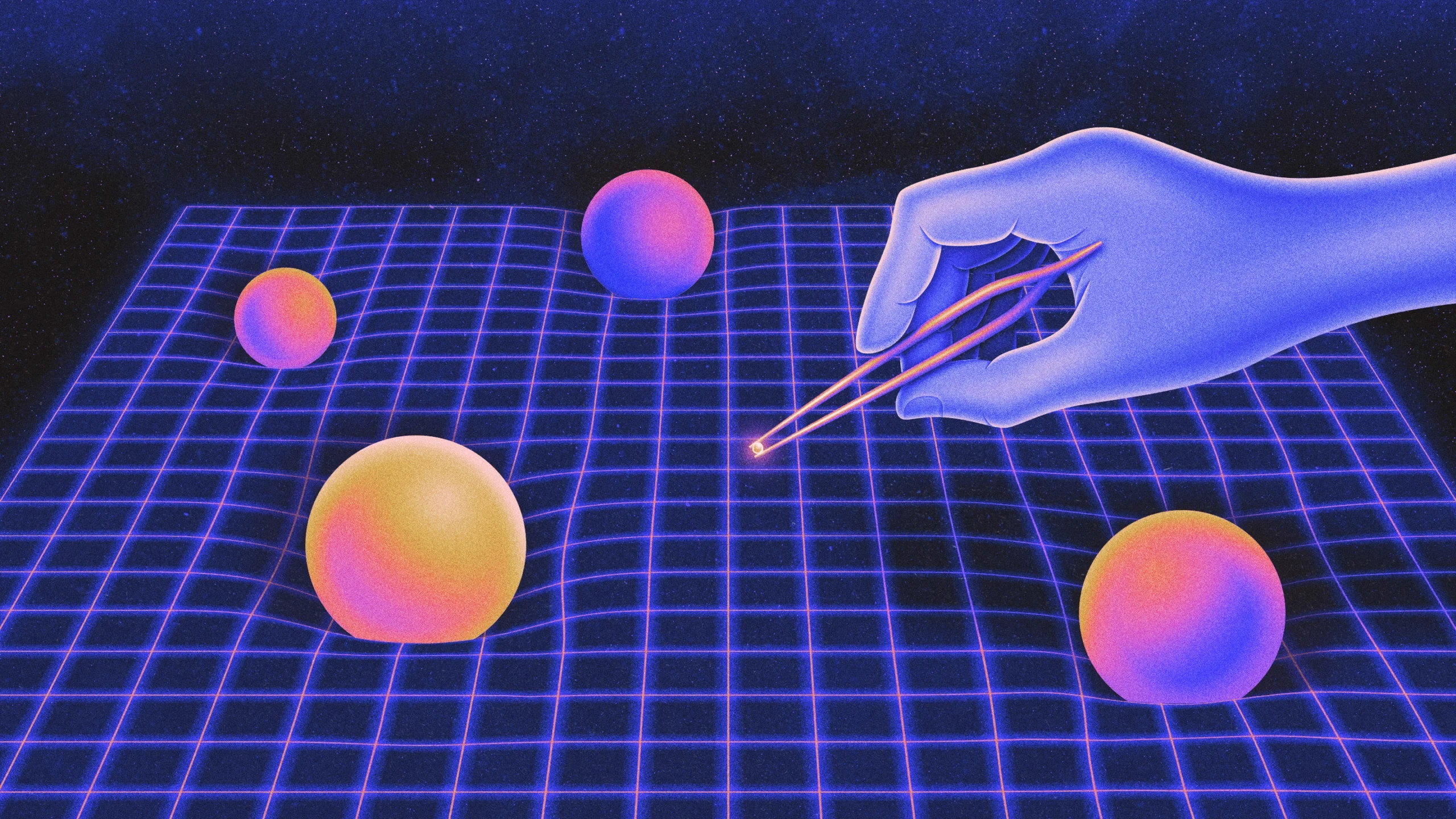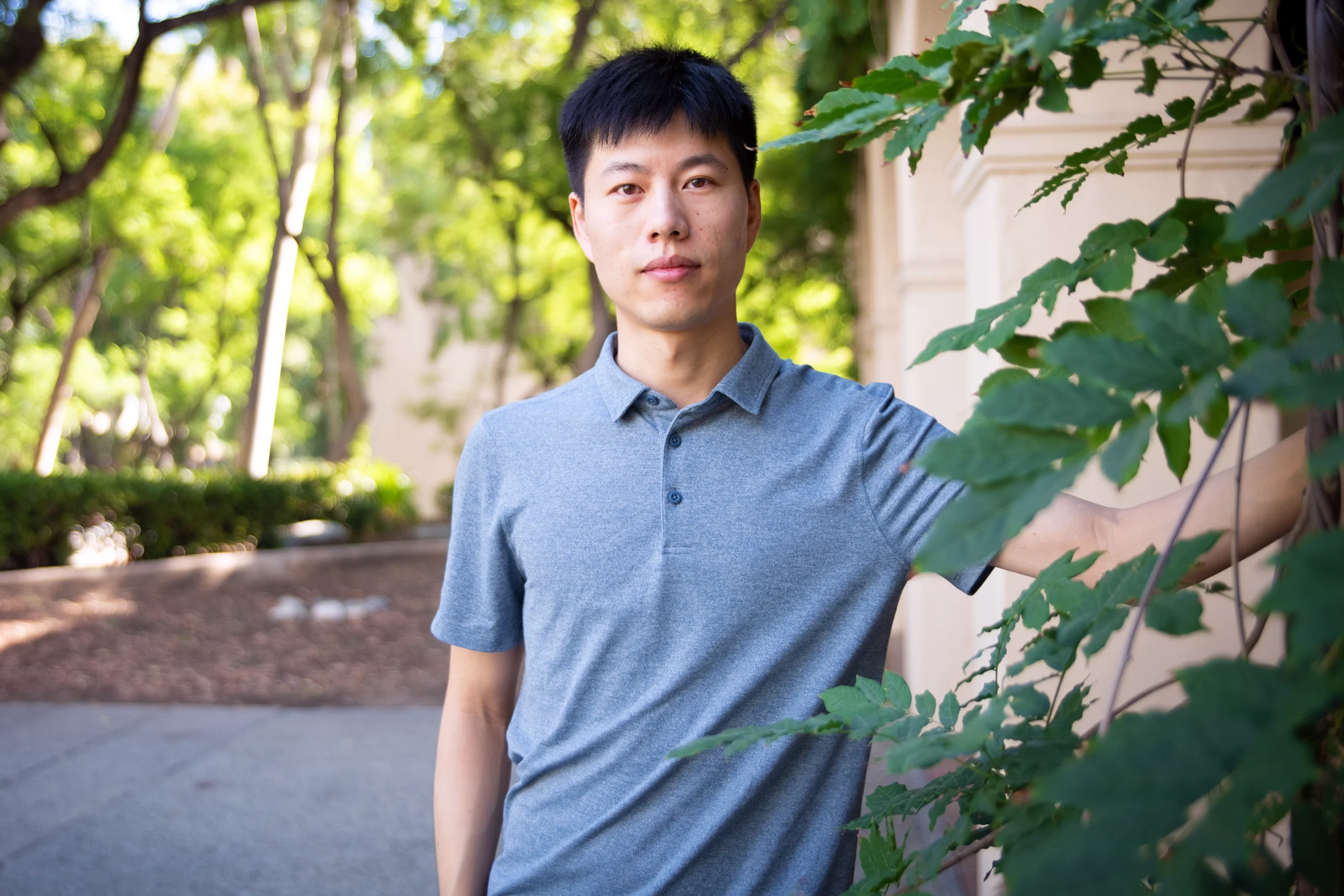A Century Later, New Math Smooths Out General Relativity

Kristina Armitage/Quanta Magazine
Introduction
Albert Einstein’s general theory of relativity has been wildly successful at describing how gravity works and how it shapes the large-scale structure of the universe. It’s summed up in a saying by the physicist John Wheeler: “Space-time tells matter how to move; matter tells space-time how to curve.” Yet the mathematics of general relativity is also profoundly counterintuitive.
Because its basic equations are so complicated, even the simplest-sounding statements are difficult to prove. For example, it was not until around 1980 that mathematicians proved, as part of a major theorem in general relativity, that an isolated physical system, or space, without any mass in it must be flat.
This left unresolved the question of what a space looks like if it is almost a vacuum, having just a tiny amount of mass. Is it necessarily almost flat?
While it might seem obvious that smaller mass would lead to smaller curvature, things are not so cut and dry when it comes to general relativity. According to the theory, dense concentrations of matter can “warp” a portion of space, making it highly curved. In some cases, this curvature can be extreme, possibly leading to the formation of black holes. This could occur even in a space with small amounts of matter, if it’s concentrated strongly enough.
In a recent paper (opens a new tab), Conghan Dong (opens a new tab), a graduate student at Stony Brook University, and Antoine Song (opens a new tab), an assistant professor at the California Institute of Technology, proved that a sequence of curved spaces with smaller and smaller amounts of mass will eventually converge to a flat space with zero curvature.
This result is a noteworthy advance in the mathematical exploration of general relativity — a pursuit that continues to pay dividends more than a century after Einstein devised his theory. Dan Lee (opens a new tab), a mathematician at Queens College who studies the mathematics of general relativity but was not involved in this research, said that Dong and Song’s proof reflects a deep understanding of how curvature and mass interact.
What They Proved
The proof by Dong and Song concerns three-dimensional spaces, but first consider a two-dimensional example for the sake of illustration. Picture a flat space with no mass as an ordinary, smooth sheet of paper. A space with small mass, in this instance, might look similar from a distance — which is to say, mostly flat. However, a closer inspection might reveal some sharp spikes or bubbles popping up here and there — consequences of the clustering of matter. These random outcroppings would make the paper resemble a well-kept lawn with the occasional mushroom or stalk sticking out from the surface.

Antoine Song (pictured) and Conghan Dong proved that spaces with small amounts of mass must be nearly flat.
Lance R. Hayashida
Dong and Song proved a conjecture (opens a new tab) that was formulated in 2001 by the mathematicians Gerhard Huisken (opens a new tab) and Tom Ilmanen (opens a new tab). The conjecture states that as the mass of a space approaches zero, so too must its curvature. Huisken and Ilmanen recognized, however, that this scenario is complicated by the presence of bubbles and spikes (which are mathematically distinct from one another). They hypothesized that the bubbles and spikes could be cut off in such a way that the boundary area left behind on the surface of the space by each excision was small. They suggested, but couldn’t prove, that the space that remained after these troublesome appendages had been removed would be close to flat. They also weren’t sure how such cuts should be made.
“These questions were difficult, and I was not expecting to see a solution to the Huisken-Ilmanen conjecture,” Lee said.
At the heart of the conjecture is a measurement of curvature. Space can curve in different ways, different amounts, and different directions — like a saddle (in two dimensions) that curves up going forward and back, but down going to the left and right. Dong and Song ignore those details. They use a concept called scalar curvature, which represents the curvature as a single number that summarizes the full curvature in all directions.
Dong and Song’s new work, said Daniel Stern (opens a new tab) of Cornell University, is “one of the strongest results we have so far that shows us how scalar curvature controls [the] geometry” of the space as a whole. Their paper illustrates that “if we have nonnegative scalar curvature and small mass, we understand the structure of space very well.”
The Proof
The Huisken-Ilmanen conjecture concerns the geometry of spaces with steadily decreasing mass. It prescribes a specific method for saying how close a space with small mass is to flat space. That measure is called Gromov-Hausdorff distance, named after the mathematicians Mikhael Gromov (opens a new tab) and Felix Hausdorff. Calculating the Gromov-Hausdorff distance is a two-step process.
The first step is to find the Hausdorff distance. Suppose that you have two circles, A and B. Start with any point on A and figure out how far it is to the closest point on B.
Repeat this for every point on A. The largest distance you find is the Hausdorff distance between the circles.
Merrill Sherman/Quanta Magazine
Once you have the Hausdorff distance, you can calculate the Gromov-Hausdorff distance. To do that, place your objects in a bigger space so as to minimize the Hausdorff distance between them. In the case of two identical circles, since you could put them literally on top of each other, the Gromov-Hausdorff distance between them is zero. Geometrically identical objects like these are called “isometric.”
Measuring distance is more difficult, of course, when the objects or spaces being compared are alike but not the same. The Gromov-Hausdorff distance provides a precise measure of the similarities (or differences) between the shapes of two objects that initially lie in different spaces. “Gromov-Hausdorff distance is one of the best ways we have of saying that two spaces are almost isometric, and it gives a number to that ‘almost,’” Stern said.
Before Dong and Song could draw comparisons between a space with a small mass and a space that is perfectly flat, they had to snip off the pesky protuberances — the narrow spikes where matter is tightly packed and even denser bubbles that may harbor tiny black holes. “We cut them so that the boundary area [where the slice was made] is small,” Song said, “and we showed that the area gets smaller as the mass goes down.”
Although that tactic might sound like a cheat, Stern said it’s permissible in proving the conjecture to do a sort of pre-processing by cutting out bubbles and spikes whose area shrinks to zero as the mass decreases.
As a proxy for a space with small mass, he suggested, we might imagine a crumpled sheet of paper that, after being smoothed out again, still has sharp creases and folds. You could use a hole punch to remove the most prominent irregularities, leaving a slightly uneven piece of paper with some holes in it. As the size of those holes shrinks, so will the unevenness of the paper’s terrain. At the limit, you might say, the holes would shrink to zero, the mounds and ridges would disappear, and you’d be left with a uniformly smooth piece of paper — a genuine stand-in for flat space.
That’s what Dong and Song sought to prove. The next step was to see how these denuded spaces — shorn of their rough features — stacked up against the standard of utter flatness. The strategy they pursued made use of a special kind of map, which is a way of comparing two spaces by associating points in one space with points in another. The map they used was developed in a paper (opens a new tab) written by Stern and three colleagues — Hubert Bray, Demetre Kazaras and Marcus Khuri. This procedure can spell out exactly how close two spaces are.
To simplify their task, Dong and Song adopted another mathematical trick from Stern and his co-authors, which showed that a three-dimensional space can be divided into infinitely many two-dimensional slices called level sets, much as a hard-boiled egg can be segmented into narrow sheets by the taut wires of an egg slicer.
The level sets inherit the curvature of the three-dimensional space they comprise. By focusing their attention on level sets rather than on the bigger three-dimensional space, Dong and Song were able to reduce the dimensionality of the problem from three to two. That’s very beneficial, Song said, because “we know a lot about two-dimensional objects … and we have a lot of tools to study them.”
If they could successfully show that each level set is “kind of flat,” Song said, this would allow them to attain their overall goal of showing that a three-dimensional space with little mass is close to flat. Fortunately, this strategy panned out.
Next Steps
Looking ahead, Song said one of the field’s next challenges is to make the proof more explicit by laying out a precise procedure for getting rid of bubbles and spikes and better describing the regions that have been cut away. But for now, he admitted, “we don’t have a clear strategy to achieve that.”
Another promising avenue, Song said, would be to explore a separate conjecture (opens a new tab) that was formulated in 2011 by Lee and Christina Sormani (opens a new tab), a mathematician at the City University of New York. The Lee-Sormani conjecture asks a similar question to the one posed by Huisken and Ilmanen, but it relies on a different way of measuring the difference between shapes. Instead of considering the maximum distance between two shapes, as the Gromov-Hausdorff distance does, the Lee-Sormani approach asks about the volume of the space (opens a new tab) between them. The smaller that volume, the closer they are.
Song, meanwhile, hopes to look into basic questions about scalar curvature that are not motivated by physics. “In general relativity,” he said, “we deal with very special spaces that are almost flat at infinity, but in geometry we care about all kinds of spaces.”
“There is hope that these techniques could be of value in other settings” unrelated to general relativity, Stern said. “There is a large family of related problems,” he said, that’s waiting to be explored.



